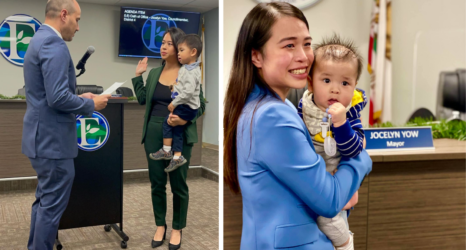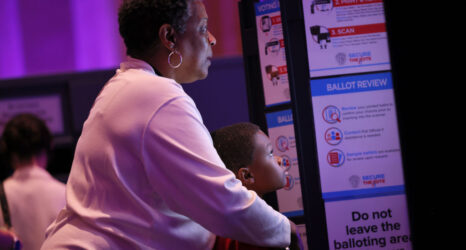With the 2018 election now in full swing, the Ms. Blog is excited to bring you content presented in conjunction with Gender Watch 2018, a project of the Barbara Lee Family Foundation and the Center for American Women and Politics. They’ll be tracking, analyzing and illuminating gender dynamics during election season—so check back with us regularly!
During this week’s primary elections, Alabama is a must-see. The state’s contest features an unprecedented number of women candidates on the ballot—70 women have launched campaigns at every level, from races for local school board seats to bids for spots in the U.S. House. In fact, Alabama leads the nation this year in Black women running for office statewide. A few of these women are incumbents, but a remarkable number are first time candidates.
The unprecedented numbers of women running in the 2018 primaries are shaking up the political scene and stand to have long reaching effects on how we talk about women and politics, as Gender Watch expert Kelly Dittmar argues. Nationwide, women are taking a new look at politics and asserting that they too want a voice at the table. But Alabama’s surge in Black women running as candidates for public office is not an “out of the blue” phenomenon, nor is it reactionary politics. Black women’s emergence there as candidates is reflective of their long-term political investments and civic participation in the state, and in other states like it, where Black women have traditions of engaging formal politics as a vehicle for societal change.
According to Melissa Michelson and Lisa Garci Bedolla’s research on get out the vote campaigns, building long-term sustained relationships with potential voters is key to mobilizing people to turn out to vote. I argue that the same is true for moving people from engaged voters into candidates for public office. The diversity reflected in Alabama’s primary this year is the result of concerted efforts by Black women to act politically on behalf of their communities and reflects their resolve to not only mobilize voters, but to also emerge as candidates in their own right.
At a conference I sponsored at The Ohio State University—The New American Electorate Beyond the Voting Booth: Building an Inclusive Democracy—we explored the building blocks for deepening citizens’ engagement with politics. Our speakers all underscored the need to build interventions that mitigate the structural and cultural barriers for women, people of color and millennials to become more engaged in politics. The researchers overwhelmingly concluded that building community infrastructures that cultivate strong political networks and promoting a sense of political efficacy—the sheer belief that voting matters and can lead to changes in public policy—were both critically necessary to sustain voter turnout among the New American Electorate of women, communities of color and new immigrant voters. We also identified these same factors as critical for transforming reliable voters into candidates for public office.
In Alabama, Black women’s sustained activism and increasing comfort with formal electoral politics as a mechanism for social change accounts for much of the surge in Black women running for office for the first time this year. But this did not happen overnight. Ten years ago, Black women in Alabama and across the nation mobilized for Barack Obama and were counted as his earliest supporters, offering the little-known candidate with the self-described ‘funny name’ substantial legitimacy when his viability was most in question. Black women’s support in early primary states turned the tide for Obama’s campaign, and they proved to be the critical voice that moved his campaign ahead.
More recently, the mobilization expertise and well-tested turnout strategies among Black women in Alabama were also essential to Doug Jones’ victory as Alabama’s first Democratic senator in 25 years. Black women supported Jones in greater numbers than any other group, stopping the campaign aspirations of alleged sexual predator Roy Moore.
Black women did in that campaign what they have done for many. They organized, particularly in communities of color, to increase voter turnout and get more people to the polls. They decided to support a candidate and then they brought a friend, a colleague, sorority sisters and church congregations to the polls. As Glynda Carr, co-founder of Higher Heights, a non-profit dedicated to getting more Black women into public office, is legendary for saying: “Black women turn up and then turnout!” That level of activism and engagement has long sustaining roots in Black women’s community activism through their churches, missionary groups, sororities, civic clubs and neighborhood associations where Black women’s leadership has always been central to delivering and caring for their communities.
Michelson and Bedolla’s research shows that maintaining established relationships matter for getting out the vote and for sustaining voter participation across election cycles. Black women who mobilized for Obama and who deployed strategies to increase turnout for Jones are all still out there, and they have a sense that their voices can change things. As I shared with a reporter for Glamour magazine recently: “There was this robust energy, and once energy like that has been released, it doesn’t go away …. once women learn [how to] get a candidate elected into office, a lightbulb comes on and they say, ‘this isn’t that hard after all. I too can do this.’”
This primary season underscores that Black women’s political groups have remained active, engaged and strategic.
Black women running and winning in the state of Alabama is also well-charted territory. Of the 17 women in the Alabama House, 10 are Black women. Three out of the four women in the Alabama Senate are Black. In fact, while Alabama ranks 45th in the number of women elected to the legislature, it ranks fifth in the number of Black women serving in the state legislature, a three-way tie shared with Mississippi and North Carolina.
In part, this is a reflection of Black Democrats’ growing success in gaining access to state legislatures despite the ever-stronger Republican Party strongholds within them. But for the Black women gaining access to these offices, their power is constrained within a minority, non-competitive party. Perhaps most notably, these Black women do not have access to state legislative leadership positions that are dictated by party control and hold the power to create the state’s legislative calendars and set policy agendas. They occupy seats that have significantly less power than they once had—but the presence of their voices in the political process is still necessary for articulating the interests of the minority party, which in this case overlaps significantly with racial minorities as well.
Black women’s presence in formal politics in Alabama is part of their legacies of civic involvement and participation in Alabama. One of the most under-valued, overlooked and under-appreciated stories of the modern civil rights movement is the role women of the Women’s Political Caucus of Montgomery played in making the 1955 bus boycott a reality and sustaining its success. Books like Danielle McGuire’s At The Dark End of the Street, which paints a multi-dimensional portrait of the anti-rape activism and investigations of Rosa Parks across the state of Alabama prior to igniting the bus boycotts, and the 2017 film The Rape of Recy Taylor also show that long before the #TimesUp and #MeToo movements, Black women in Alabama dared to stand in solidarity against sexual violence. Black women’s support of Doug Jones and their emergence as candidates in this primary season continue this historic tradition of using their voices to stand against sexual violence.
Political parties seldom have faith that Black women candidates are capable of winning. In far too many cases, Black women are labeled as non-viable candidates and do not garner the critical support of their party. Perhaps one of the most famous of those extended the “non-viable” marker was Congresswoman and presidential candidate Shirley Chisholm—and, much like her, many Black women candidates are famous for proving wrong those who count them out.
In this contemporary moment, in Alabama and nationwide, Black women voters and candidates are bringing new energy to electoral politics—the kind, coming fresh off the loss of a presidential election, communities across the country could use. We need only to point to the overwhelming gubernatorial primary victory of Stacey Abrams in the neighboring state of Georgia, where Black women mobilized nationally in support of her candidacy, as proof that backing a ground game that invests in a broad array of diverse communities, offering support for voter education, mobilizing voters in communities of color and making long-term investments in identifying, recruiting and training the next generation of Black women candidates is a pathway to success for political parties at every level.
Nothing says it better than two hashtags that are taking the internet by storm: #BlackWomenLead and #TrustBlackWomen.





